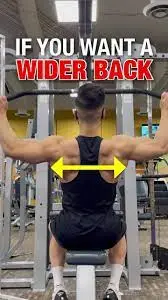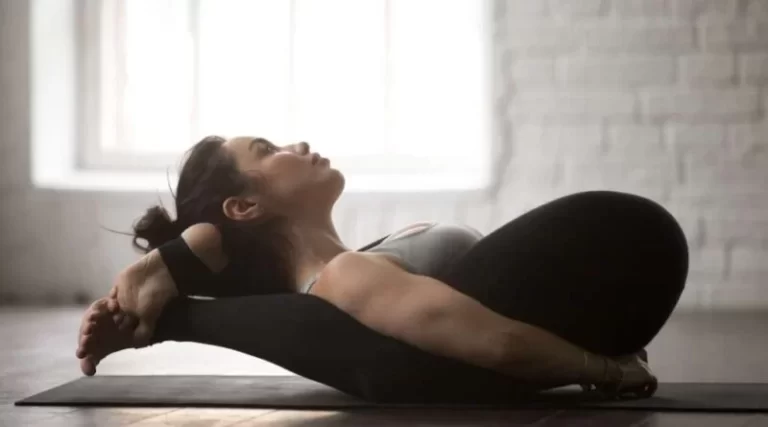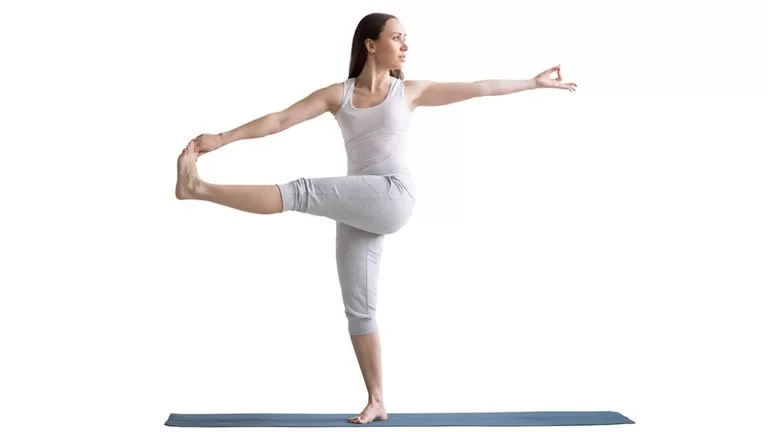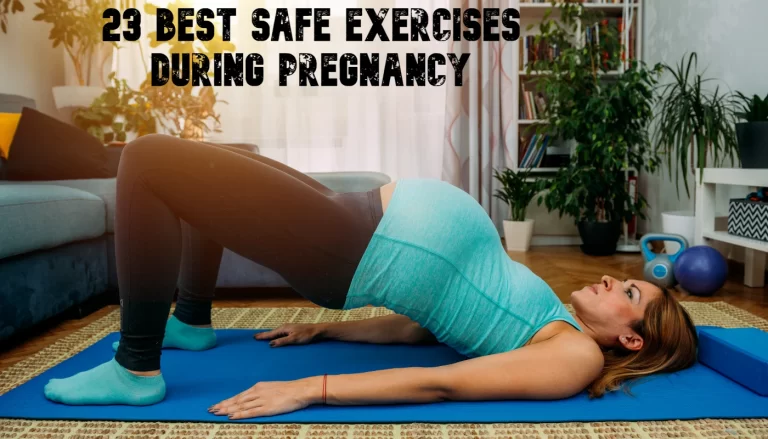9 Best Exercises to Gain a Wide-Back
If you aim to gain a wide back then you have to train your traps, lats, or even your rear delts, including these back workouts into your activities will be a key part of your overall fitness plan. Compound exercises, which work for several muscular groups and significantly increase strength and growth, are among them.
Compound movements that engage these muscles are particularly effective. In addition to being aesthetically pleasing, a well-developed back is essential for general strength and posture. Gaining width is a common aim for many fitness enthusiasts among the many different muscle groups that make up the back.
In addition to creating the appearance of a lower waist by enhancing the V-tapered silhouette, a wider back also improves the stability and usefulness of the upper body.
Introduction
This post will go into great detail about back exercises that build width by strengthening your back. It will also show you a wide range of methods and exercises that may be used to build a strong and impressive posterior chain.
These workouts will help you get the kind of back that demands attention and radiates strength, regardless of your level of experience in the gym or level of fitness.
Anatomy of the Back
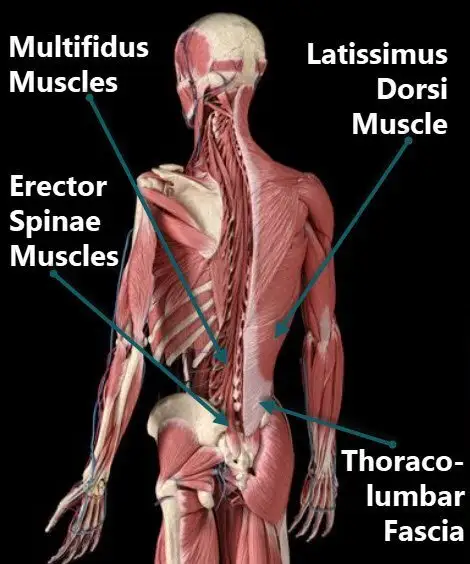
Because of its large surface area and range of motion, the back has a significant number of muscles. However, there’s one key muscle to focus on if you want a wider back. That is the latissimus dorsi, sometimes known as the lats. Large muscles running down the side of your body, under your armpits, are called lats. Large lats resemble wings similar to that of a wingsuit, which is why bodybuilders commonly refer to them as “wings” when performing the lat spread.
But developing a wider, larger back requires more than just strengthening your back muscles. Having a slim waist and side delts are two more crucial muscles. As a result, the upper back’s broad foundation will taper into the waist’s narrower base, forming a V shape.
Tips for Building a Wider Back
Make sure to use your lats
The latissimus dorsi, or lat, muscles are a major factor in developing a broader back. The latissimus dorsi is a broad muscle group that runs from the upper arm bone to the lower spine and is found on both sides of the back. These muscles, when trained and used appropriately, are essential for building thickness and width in the back.
It is imperative to concentrate on lat-targeting workouts if you want to grow a wider back. Lat pull-downs and wide-grip pull-ups are two pull-up variations that work the lats quite well. These workouts include pushing your body weight or a weighted resistance down towards your upper body, working the lats, and fostering muscle growth.
You can specifically target and stress the lats with exercises that target them, which will promote general development and muscle hypertrophy. Growing and strengthening lats add to the appearance of a wider back, creating the appearance of a larger frame. Consistent and gradual exercise, combined with good form and technique, will help you establish a wider back by focusing on the development of the latissimus dorsi muscles.
Make sure to stretch before the workout
Stretching before exercise helps increase flexibility and prepare the relevant back muscles for action, which helps activate all of them. Stretching increases the suppleness and range of motion of the muscles and surrounding connective tissues by gently elongating them. Improved muscular activation during exercise is facilitated by this technique. Before working out, we can enhance blood flow to the back muscles, which will provide more oxygen to the area. The muscles become primed for action and are helped to warm up by this. Stretching also facilitates a wider range of motion during exercise by releasing tension and tightness in the back.
Additionally, proprioceptors in the muscles—which communicate with the brain regarding the position and movement of the body—are activated by stretching. The activation of all the back muscles used in the exercise is enhanced and helps to improve muscle coordination.
It’s crucial to remember that dynamic stretching is usually preferred to static stretching. By putting your joints and muscles through their entire range of motion, dynamic stretching helps you prepare for the kinds of movements you’ll be performing during your workout. This kind of stretching improves blood flow, boosts body temperature, enhances range of motion, and activates the muscles you’ll be using.
It offers a firm basis for successful and safe training, lowering the risk of injury and maximizing the performance of the back muscles. On the other hand, static stretching entails maintaining a stretch without moving for a long time. While static stretching can be good for improving flexibility, it’s not ideal for warming up before a strength workout. Research suggests that static stretching can temporarily diminish muscle strength and power if performed right before a workout, which is counterintuitive for strength training.
Use a wider grip
When performing exercises like lat pulldowns, pull-ups, or rows, using a broader grip will help you engage your back muscles more effectively. Lever length is increased by the wider grip, resulting in a longer movement at the shoulder joint between the axis of rotation and the resistance.
This puts more focus on the lats, rhomboids, and trapezius, which are the muscles that are in charge of scapular retraction and shoulder extension. Furthermore, a wider grip increases the range of motion and extends the target muscles more, which causes a rise in muscular activation. It’s essential to remember that, although a broader grip can improve back muscular activation, it may also cause the biceps and forearm muscles to become more involved. For best effects, it is therefore essential to have the correct form and concentrate on using the back muscles during the exercise.
Activate The Lats
Since they are unable to feel their lats contracting, many lifters are unable to develop a broad back. When doing back exercises, there are various methods to increase lat activation so that you can feel them working. Before your pulldowns or rows, you can first conduct an activity that helps you feel your lats with light loads. The perfect exercise is the straight-arm pulldown. Since the lats play a major role in shoulder extension, you can squeeze them with each rep of the straight-arm pulldown. Once your warm-up is complete, perform 2-3 sets of 10–20 repetitions to get ready to take on your back training.
Before you even consider adjusting the weight during your broad back exercise, you should think, “Squeeze the lats,” with each repetition. It has been demonstrated that doing this will significantly double your muscle size. Having a training partner give you instructions while you pulldown and row using these components is another method.
- During the workout, palpate your lats by lightly touching them.
- you have to target the lats only.
- Guide you to do exercise with your back muscles and not your arms.
Just doing this is enough to increase lat activation by 17% without increasing biceps activation. Thus, the essential trio of lat development consists of using the straight arm pulldown to engage the lats during warm-up, squeezing the lats during the exercises, and getting guidance from a training partner when performing the lift.
Give a wide grip and stop.
You can lift more weights with a medium grip width than with a broad grip width. Higher loads result in increased mechanical strain and, thus, larger muscle growth. Furthermore, a wide grip reduces the lats’ range of motion, which means that less effort is made when lifting for shorter periods under tension. Use a medium grip width for the stick.
Use Pronated Grips
When performing pull-ups and pulldowns, pronated grips (palms away) activate the lats more than supinated grips (palms towards). Because they are in a better position to contribute to the workout, supinated grips enhance the activation of the biceps.
Pull Your Way To A Wide Back
When it comes to back exercises, pull-ups exhibit the highest level of lat activation. Not far behind is the lat pulldown. The rows are excellent. Pulldowns and pull-ups are your best bet, though, when working the lats for back width.
High Reps With Heavy Weight
One of the few muscle groups capable of handling both high repetitions with big weights is the lats (as well as the back musculature generally). The most noteworthy is the Kroc row, which Matt Kroczaleski popularised. According to the narrative, he performed 1-arm dumbbell rows while maxing out his dumbbells.
He chose to set personal rep records rather than weight records because he was unable to add more load. Since then, it has evolved into an exercise that involves using extremely heavy dumbbells to accomplish sets of 20 or more repetitions. Your lats will get thicker with this exercise, and your back will get wider.
Train Your Side Delts
But wait the side delts aren’t back muscles? You’d be correct. However, a broad torso consists of more than just powerful back muscles. Your back’s width will be rounded out by your side delts. It will help widen the top of the V taper, so your waist does not need to be as thin.“The back muscles are the foundation of the body. The foundation of a magnificent building must be strong to support it.
The Best Exercises for a Wide Back
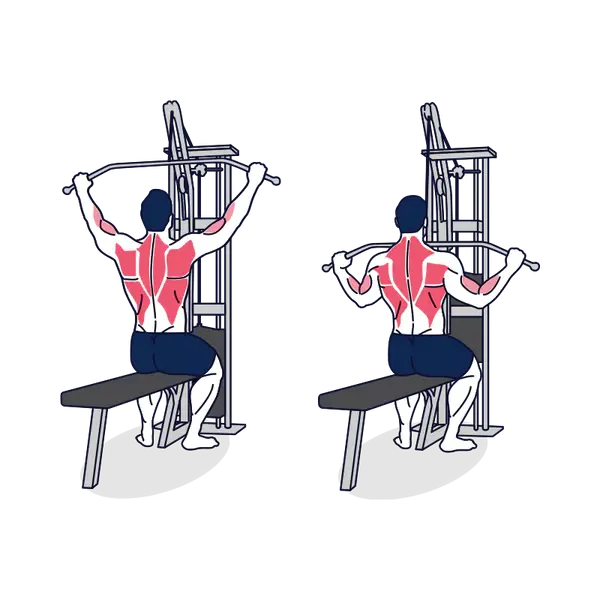
Wide grip lat pulldowns
This combination movement mainly targets the lats but also contracts other muscle groups such as the biceps, rear deltoids, and trapezius. Containing wide-grip lat pulldowns into your training routine can enhance your posture, improve upper limb strength, and improve overall muscle development.
Make sure your feet are flat on the floor and your thighs are securely fastened by adjusting the seat height and thigh pad on the machine. Using an overhand grip, place your hands slightly wider than shoulder-width apart to grab the wide bar.
- Sit with your shoulders lowered, chest raised, and back straight. Keep your feet firmly planted and maintain a slight backward tilt.
- Squeeze your shoulder blades together and compress your shoulders to begin the exercise. This works the lats and gets them ready for the workout.
- Keeping your elbows out to the sides, pull the bar down towards your upper chest. Instead of depending only on your arms, concentrate on engaging your back muscles. Without touching it, try to get the bar as near to your chest as you can.
- To get the most out of the contraction, stop when the bar reaches its lowest position and tense your back muscles.
- Return to the starting position under control, and then gradually raise the bar again while fully extending your arms and not letting your shoulder muscles rest.
- For the required amount of repetitions, repeat.
Reverse grip rows
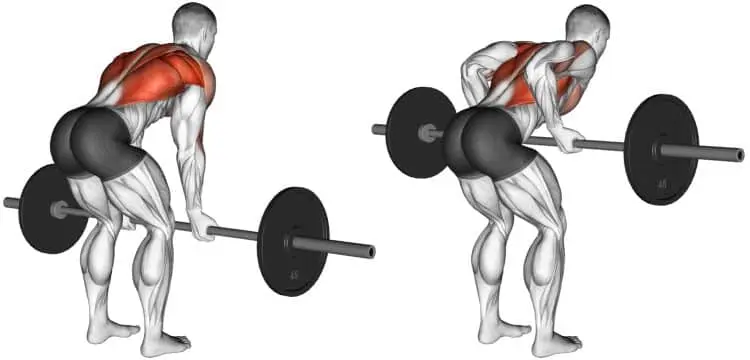
The exercise known as the supine grip row, or reverse grip row, is a variation of the regular grip row in which you use an underhand hold rather than an overhand grasp on the barbell or handle.
Although the back muscles are the main focus of both workouts, there are notable distinctions, particularly in the way the muscles are recruited. The reverse grip row emphasizes the biceps more than the major back muscles (such as the lats) and may also draw attention to smaller back muscles (like the rhomboids and lower traps).
- To begin, place your feet shoulder-width apart and bend your knees slightly. With your hands facing up, take an underhand grip on a barbell or dumbbell.
- Keeping your back straight and your core active, hinge at the hips. Lean your arms out to the fullest, perpendicular to the ground.
- Swing the weight in the direction of your lower chest, keeping your shoulder blades close together. As you perform the exercise, keep your elbows tight to your torso.
- At the peak of the exercise, pause for a brief period before lowering the weight gradually and completely extending your arms to the beginning position.
- Keep good form and control throughout the exercise as you repeat for the target number of repetitions.
- Reverse grip rows can also be done differently by utilizing resistance bands or a cable machine, and securing the handle or band to a low anchor point.
Dumbbell pullovers

This adaptable exercise works the triceps, back, and chest muscles in addition to improving shoulder mobility and core stability. This can encourage greater posture and shoulder stability, which will visually enlarge your back. Using both hands, hold a single dumbbell so that your thumbs and index fingers create a triangle and your palms are pressed against the bottom of the top weight plate.
- Place your feet firmly on the floor and support your head while you lie down on a level bench.
- Raise your arms overhead and flex your elbows just a little bit. Throughout the exercise, hold onto the dumbbell with a tight grip. To keep your body stable and your spine in a neutral position, brace your core muscles.
- Keep your elbows slightly bent as you carefully lower the weight behind your head. To prevent tension on your shoulder joints, maintain a straight-arm posture and refrain from allowing the weight to shift too far back.
- Raise the dumbbell back to the starting position using the same technique in a smooth and controlled manner. Instead of depending exclusively on your arms to raise the weight back up, concentrate on engaging your chest and back muscles.
- Continue till the desired number of times.
Seated resistance band row
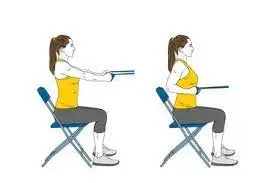
Theraband Rows
- For people of all fitness levels, the Seated Resistance Band Row is a great exercise that has several advantages.
- You may strengthen your upper body, increase general muscular endurance, and improve posture by incorporating the Seated Resistance Band Row into your training program. Attach a resistance band at waist height to a strong anchor point. With your legs out in front of you, take a seat on the floor or a bench, and wrap the band over your feet.
- With an overhand grip and relaxed shoulders, completely stretch your arms to grasp the handles of the resistance band.
- Pull the resistance band towards your torso and retract your shoulder blades to start the workout. Try to bring your elbows back.
- When you reach the end of the range, squeeze your shoulder blades together. Then, slowly return to the beginning position, keeping the band taut and under control the entire time.
- For the required amount of repetitions, repeat.
Long-angle dumbbell row
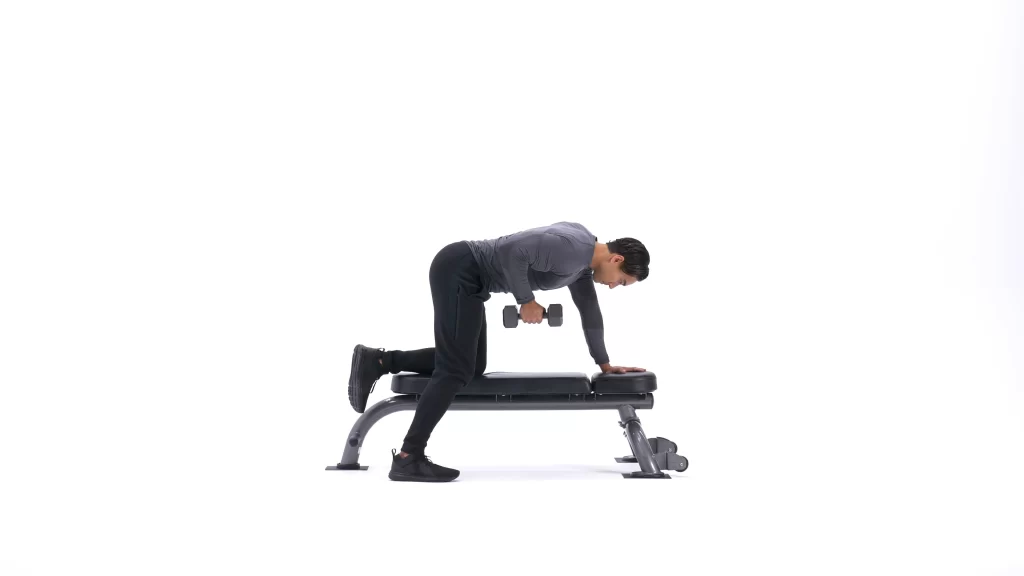
The Long Angle Dumbbell Row is a very powerful workout that develops a wider and stronger back. This results in increased growth and recruitment of muscle fibers, which gives the illusion of a more solid and broader back. Furthermore, the movement’s unilateral character addresses any potential muscular imbalances while fostering symmetrical growth and general back strength.
- Starting with a flat bench and a dumbbell on either side, take a position on the bench with your back straight and parallel to the floor, resting one knee and one hand on it.
- Hold the dumbbell in a neutral grip with your palm facing your body while keeping your opposing foot firmly planted on the ground.
- Pull the dumbbell up in a rowing motion until it reaches your hip, keeping your back level and your core tight. Squeeze your shoulder blades together during this movement.
- Allowing your arm to fully extend without rounding your back, slowly lower the dumbbell back to the starting position.
- After completing the necessary number of repetitions, switch sides to work the opposing arm.
Standings cable rope pullover

The cable rope pullover offers a wider range of motion than other back workouts, especially during the eccentric (lengthening) phase. The back muscles are put under a lot of strain by this continuous resistance, which increases strength and hypertrophy (muscle growth).
- The cable machine should be positioned just above your head. Make sure the cable is firmly secured before attaching a rope to it.
- Your feet should be shoulder-width apart as you stand facing the cable machine. Throughout the workout, keep your knees slightly bent and contract your core for stability.
- Make sure your hands are shoulder-width apart when you grasp the rope with an overhand grip.
- Exhale, stretch your arms forward, parallel to the ground, and keep your elbows slightly bent while keeping your arms straight.
- Pulling the rope in the direction of your body and retracting your shoulder blades will start the action. Instead of depending only on your arms, concentrate on engaging your back muscles. Maintain a parallel arm position with your elbows slightly bent. Feel the muscles in your upper back contract as you squeeze your shoulder blades together.
- Take a slow step forward and back to the starting position. Throughout the exercise, keep control and don’t allow the weight stack to fall.
Pull-ups (Wide grip and close grip)
Wide and close-grip varieties of pull-ups are excellent workouts for developing a wider and stronger back. This is a strenuous, difficult exercise that can be modified for beginners. You may strengthen your back in a well-rounded way by using wide-grip and close-grip pull-ups in your training regimen. This will help you gain a stronger back, better posture, and a wider back appearance.
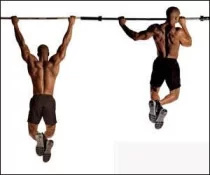
Wide Grip Pull-ups:
- Select a pull-up bar and spread your hands somewhat more widely than the breadth of your shoulders.
- With your arms outstretched and your palms facing away from you, hang from the bar.
- As you raise your body towards the bar, tighten your shoulder blades and engage your core.
- Aim to lift your chin above the bar, pausing momentarily after you reach the top.
- Retrace your steps to the beginning point slowly and deliberately.
- Continue till the desired number of times.
Close Grip Pull-ups:
- Find a pull-up bar and place your hands a little less apart than shoulder width.
- With your arms outstretched and your palms facing you, hang from the bar.
- As you raise your body towards the bar, contract your core muscles and concentrate on bringing your elbows back and down.
- Try to lift your chin above the bar and stay there for a little while.
- With deliberate slowness, return to your starting position while keeping your muscles taut.
- For the required amount of repetitions, repeat.
Lateral raises
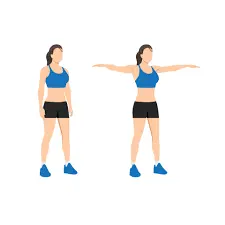
Although lateral rises aren’t strictly a back workout, they do assist in building shoulder muscles, which might give the impression that the back is wider overall. Lateral raises also contribute to the development of the back’s supporting muscles, such as the rhomboids and trapezius, which results in a more muscular and defined back appearance.
- To start this exercise you have to stand straight and hold the dumbbell in your hands With your palms pointing inward, keep your arms out by your sides.
- Throughout the workout, keep your elbows slightly bent and engage your core.
- Raise both arms to the sides at the same time until they are shoulder level while maintaining a straight back and not swinging.
- Squeeze your shoulder muscles and take a moment to pause at the top, with your hands facing the floor.
- Return the dumbbells to their initial position slowly, then continue for the required amount of repetitions.
A Guide to a Wider Back
Work the right muscles
Your back appears wide because of the lats, teres major, and teres minor muscles. This is because they provide the illusion of a bigger back by drawing attention to the area beneath your arms. Working the lats also synergistically works the other two muscles. For optimum hypertrophy, concentrate on training these muscles in the 8–12 rep range.
Burn belly fat
Your waist size decreases when you burn the fat around your obliques, sometimes referred to as your love handles. As a result, you appear to have a wider back because your shoulders and lats appear larger than they are. Regretfully, there isn’t a natural approach to target specific belly fat areas. There are just two ways to do this: daily exercising and a calorie deficit.
Pack your lats
Try to activate your lats throughout the movement when performing exercises that target the mid back, such as deadlifts, barbell rows, or other similar movements. This guarantees that during your recuperation, your lats put in the required effort, break down, and expand.
Safety precautions
- Use good form: By using correct form, you may help avoid injury and make sure you’re focusing on the muscles that will help you grow in this case, your lats.
- Hydrate: The discomfort from back cramps is intense. To avoid cramping up in the middle of a strenuous lift, make sure you’ve had enough water before beginning.
- Sleep: Lat exercises are really hard and exhausting. Getting a good night’s sleep may help in muscle growth and recovery, making you stronger.
- Recovery supplements: After a strenuous workout, refueling your lats with a high-quality whey protein supplement is simple and convenient.
FAQ
How is a V-shaped back achieved?
Increasing the size of your lat and shoulder muscles and decreasing the fat surrounding your obliques will give you a V-shaped back. For the former, hypertrophy centered on the lats and shoulders is necessary; for the latter, fat loss is an option.
Why is the back so thick?
The backer becomes thicker when you work on your rhomboids and traps. By focusing on the muscles that go horizontally across your back, you can enlarge them and give the appearance that your back is thicker.
Do you look bigger if your back is wider?
You do appear larger if you have a wider back. Furthermore, broader shoulders elongate your back. Increase the width of your shoulders by including deltoid workouts such as overhead lifts, lateral raises, and shrugs.
Is your back thicker or wider after rows?
Depending on the technique, rows might make your back appear broader or wider. Lats work, which targets back width, when you perform rows with a close grip. Your back gets bigger when you perform rows with flared elbows because they target the muscles in your upper back.
Which physical activities broaden the back muscles?
Exercises that focus on the biggest muscular mass should be done. Compound movements, such as deadlifts, bench presses, shoulder presses, rows, and squats, are what determine thickness and width.” Among the greatest workouts for building total size is the squat.
References
- BOXROX. (2023, December 11). https://www.boxrox.com/the-8-best-exercises-for-a-wider-back-2/
- Z, T. (2023b, August 23). 8 exercises to build a wider back + sample workout. TRX Training – United States. https://www.trxtraining.com/blogs/news/wide-back-exercises
- Cpt, J. C. B. (2023, December 10). 5 Best exercises for wider back (Chiseled V-shaped muscles). Total Shape. https://totalshape.com/training/best-exercises-for-wider-back/
- The 5 best LaT Exercises for building a Bigger, Wider Back | Gymshark Central. (n.d.). https://central.gymshark.com/article/the-5-best-lat-exercises-for-building-a-bigger-wider-back

